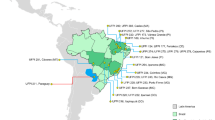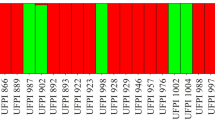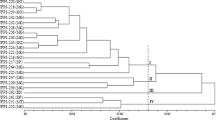Abstract
Lima bean (Phaseolus lunatus L.) is an important food source in Brazil, especially in the northeast region, where its production and consumption are high. The goals of the present study were to estimate natural outcrossing rates and genetic diversity levels of Lima bean from Brazil, using ten microsatellite loci to obtain information for their conservation and breeding. Fourteen accessions were selected from an experiment in field with open-pollinated and with the presence of pollinating insects. Twelve seeds of each of the 14 selected accessions were grown in screenhouse for tissue harvest and DNA extraction. The multilocus model was used to determine the reproductive system. The outcrossing rate was 38.1 % (tm = 0.381; ts = 0.078), and the results indicated a mixed mating system with a predominance of selfing (1 − tm = 61.9 %). The biparental inbreeding rate was high (t m − t s = 0.303) and the multilocus correlated paternity was quite high (r p(m) = 0.889), indicating that the progeny was mostly composed of full sibs. The average effective number of pollen donors per maternal plant (N ep ) was low (1.12), and the fixation index for maternal genotypes (F m ) was 0.945, indicating that most genitors resulted from inbreeding. The studied families presented considerable genetic variability: A = 6.10; %P = 30; H e = 0.60 and H o = 0.077. Total diversity was high (H T = 0.596), and a portion was distributed within families (H S = 0.058). In addition, diversity was higher between families (D ST = 0.538), and genetic differentiation was high (G ST = 0.902). The results presented here can be used in the implementation of Lima bean conservation and breeding programs in Brazil.
Similar content being viewed by others

References
Azevedo JN, Franco LJD, Araújo ROC (2003) Composição química de sete variedades de feijão-fava. Embrapa Meio-Norte, Teresina
Baudet JC (1977) The taxonomic status of the cultivated types of Lima bean (Phaseolus lunatus L.). Trop Grain Legume 7:29–30
Baudoin JP (1988) Genetic resources, domestication and evolution of Lima bean, Phaseolus lunatus. In: Gepts P (ed) Genetic resources of Phaseolus bean. Kluwer Academic Publishers, Amsterdam, pp 393–407
Baudoin JP, Rocha O, Degreef J, Maquet A, Guarino L (2004) Ecogeography, demography, diversity and conservation of Phaseolus lunatus L. in the central valley of Costa Rica. Systematic and ecogeographic studies on crop genepools. Int Plant Genet Resourc Inst, Rome
Borém A, Miranda GV (2009) Melhoramento de plantas, 5th edn. UFV, Viçosa
Burle ML, Fonseca JR, Kami JA, Gepts P (2010) Microsatellite diversity and genetic structure among common bean (Phaseolus vulgaris L.) landraces in Brazil, a secondary center of diversity. Theor Appl Genet 121:801–813
Buso GSC, Ciampi AY, Moretzhon MC, Amaral ZPS, Brondani RV (2003) Marcadores microssatélites em espécies vegetais—desenvolvimento e caracterização de marcadores microsatélites em espécies vegetais tropicais. Biotecnol Ciênc Desenvolv 30:46–50
Carmo MDS, Gomes RLF, Lopes ACA, Penha JS, Gomes SO, Assunção Filho JR (2013) Genetic variability in subsamples of determinate growth Lima bean. Crop Breed Appl Biotechnol 13:158–164
Castiñeiras L, Guzmán FA, Duque MC, Shagarodsky T, Cristóbal R, De Vicente MC (2007) AFLPs and morphological diversity of Phaseolus lunatus L. in Cuban home gardens: approaches to recovering the lost ex situ collection. Biodivers Conserv 16:2847–2865
Doyle JJ, Doyle JL (1987) Isolation of plant DNA from fresh tissue. Focus 12:13–15
Fausto JA, Eckhart VM, Geber MA (2001) Reproductive assurance and the evolutionary ecology of self-pollination in Clarkia xantiana. Am J Bot 88:1794–1800
Ferreira ME, Moretzsohn MC, Buso GSC (2007) Fundamentos de caracterização molecular de germoplasma vegetal. In: Nass LL (ed) Recursos genéticos vegetais. Embrapa Recursos genéticos e Biotecnologia, Brasília, pp 379–420
Gaitán-Solís E, Duque MC, Edwards KJ, Tohme J (2002) Microsatellite repeats in common bean (Phaseolus vulgaris L.): isolation, characterization, and cross-species amplification in Phaseolus ssp. Crop Sci 42:2128–2136
Goudet J (2002) FSTAT, a program to estimate and test gene diversities and fixation indices. Version 2.9.3.2. Université de Lausanne, Lausanne. http://www.unil.ch/popgen/softwares/fstat.htm. Acesso 22 dezembro 2013
Guimarães WNR, Martins LSS, Silva EF, Ferraz GMG, Oliveira FJ (2007) Caracterização morfológica e molecular de acessos de feijão-fava (Phaseolus lunatus L.). Rev Bras de Eng Agrícola e Ambient 11:37–45
Hamrick JL (1982) Plant population genetics and evolution. Am J Bot 69:1685–1693
Hamrick JL, Loveless MD (1986) Isozyme variation in tropical trees; procedures and preliminary results. Biotropica 8:201–207
Hamrick JL, Murawski DA (1991) Levels of allozyme diversity in populations of uncommon neotropical tree species. J Trop Ecol 7:395–399
Harding J, Tucker CL (1964) Quantitative studies on mating systems. I. evidence for the non-randomness of outcrossing in Phaseolus lunatus. Heredity 19:369–381
Hardy O, Dubois S, Zoro BII, Baudoin JP (1997) Gene dispersal and its consequences on the genetic structure of wild populations of Lima bean (Phaseolus lunatus) in Costa Rica. Plant Genet Resour Newsl 109:1–6
Jiang GL (2013) Molecular markers and marker-assisted breeding in plants. In: Andersen SB (Ed) Plant breeding from laboratories to fields. InTech, University of Copenhagen. doi:10.5772/3362
Kageyama PY, Sebbenn AM, Ribas LA, Gandara FB, Castellen M, Perecim MB, Vencovsky R (2003) Diversidade genética em espécies arbóreas tropicais de diferentes estágios sucessionais por marcadores genéticos. Sci For 64:93–107
Kaplan L, Lynch TF (1999) Phaseolus (Fabaceae) in archaeology: AMS radiocarbon dates and their significance for pre-Colombian agriculture. Econ Bot 53:261–272
Lewis P, Zaykin D (2000) Genetic data analysis: computer program for the analysis of allelic data version 1.0. http://www.eeb.uconn.edu/people/plewis/software.php. Accessed 27 Dec 2013
Lopes ACA, Gomes RLF, Araújo ASF (2010) A cultura do feijão-fava no Meio-Norte do Brasil. EDUFPI, Teresina
Maquet A, Zoro Bi I, Delvaux M, Wathelet B, Baudoin JP (1997) Genetic structure of a Lima bean base collection using allozyme markers. Theor Appl Genet 95:980–991
Martinez-Castillo J, Zizumbo-Villarreal D, Gepts P, Delgado-Valerio P, Colunga-Garcíamarín P (2006) Structure and genetic diversity of wild population of Lima bean (Phaseolus lunatus L.) from the Yucatan Peninsula. Mex Crop Sci 46:1071–1080
Martinez-Castillo J, Colunga-Garcíamarín P, Zizumbo-Villarreal D (2008) Genetic erosion and in situ conservation of Lima bean (Phaseolus lunatus L.) landraces in its Mesoamerican diversity center. Genet Resour Crop Evol 55:1065–1077
Martínez-Castillo J, Zizumbo-Villarreal D, Perales-Rivera H, Colunga-GarcíaMarín P (2004) Intraspecific diversity and morpho-phenological variation in Phaseolus lunatus L. from the Yucatan Peninsula, Mexico. Econ Bot 58(3):354–380
Martínez-Castillo J, Camacho-Pérez L, Coello-Coello J, Andueza-Noh R (2012) Wholesale replacement of Lima bean (Phaseolus lunatus L.) landraces over the last 30 years in northeastern Campeche, Mexico. Genet Resour Crop Evol 59:191–204
Martínez-Castillo J, Camacho-Pérez L, Villanueva-Viramontes S, Andueza-Noh RH, Chacón-Sánchez MI (2014) Genetic structure withinthe Mesoamerican gene pool of wild Phaseolus lunatus (Fabaceae) from Mexico as revealed by microsatellite markers: implication for conservation and the domestication of the species. Am J Bot 101(5):1–14
Montero-Rojas M, Ortiz M, Beaver JS, Siritunga D (2013) Genetic, morphological and cyanogen content evaluation of a new collection of Caribbean Lima bean (Phaseolus lunatus L.) landraces. Genet Resour Crop Evol 60:2241–2252
Nei M (1973) Analysis of gene diversity in subdivided populations. Proc Natl Acad Sci USA 70:3321–3323
Oliveira AP, Alves EU, Alves AU, Dornelas CSM, Silva JA, Porto ML, Alves AV (2004) Produção de feijão-fava em função do uso de doses de fósforo em um neossolo regolítico. Hortic Bras 22:543–546
Ortega SV (1974) Polinización cruzada natural de la caraota (P.vulgaris L.) en Venezuela. Agron Trop 24:27–32
Ramalho MAP, Santos JB, Abreu AFB, Nunes JAR (2012) Aplicações de genética quantitativa no melhoramento de plantas autógamas, 1st edn. UFLA, Lavras
Ritland K (1989) Correlated matings in the partial selfer Mimulus guttatus. Evolution 43:848–859
Ritland K (1990) A series of fortran computed programs for estimating plant mating systems. J Hered 81:235–237
Ritland K (2008) Multilocus mating system program MLTR (Software) version 3.2. http://genetics.forestry.ubc.ca/ritland/programs.html. Accessed 27 Dec 2013
Ritland K, Jain SK (1981) A model for the estimation of outcrossing rate and gene frequencies using independent loci. Heredity 47:35–52
Santos D, Corlett FMF, Mendes JEMF, Wanderley Júnior JSA (2002) Produtividade e morfologia de vagens e sementes de variedades de fava no Estado da Paraíba. Pesqui Agropecu Bras 37:1407–1412
Sebbenn AM, Siqueira ACMF, Kageyama PY, Machado JAR (1998) Parâmetros genéticos na conservação de cabreúva—Myroxylon peruiferum LF Allemão. Sci For 53:31–38
Sebbenn AM, Kageyama PY, Siqueira ACMF, Zanatto ACE (2000) Sistema de cruzamento em populações de Cariniana legalis (Mart.) O. Ktze.: impli-cações para a conservação e o melhoramento genético. Sci For 58:25–40
Valls JFM (2007) Caracterização de recursos genéticos vegetais. In: Nass LL (ed) recursos genéticos vegetais. Embrapa Recursos Genéticos e Biotecnologia, Brasília, pp 281–342
Webster BD, Lynch SP, Tucker CL (1979) A morphological study of the development of reproductive structures of Phaseolus lunatus L. J Am Soc Hort Sci 104:240–243
Wright S (1921) Systems of mating. Genetics 6:111–178
Zoro Bi I (1999) Variabilité génétique des populations sauvages de Phaseolus lunatus L. dans la vallée centrale du Costa Rica et ses implications dans la mise ou point d’ une stratégíe de conservation in situ. Ph. D. thesis. Faculté Universitaire des Sciences Agronomiques, Gembloux, Belgium
Zoro Bi I, Maquet A, Baudoin JP (2005) Mating system of wild Phaseolus lunatus L. and its relationships with population size. Heredity 94:153–158
Acknowledgments
The authors thank the Laboratory of Genetic Diversity and Breeding of the Luiz de Queiroz College of Agriculture (ESALQ), where the present study was performed. Thanks are also due to Conselho Nacional de Desenvolvimento Científico e Tecnológico - CNPq for the financing and Coordenação de Aperfeiçoamento de Pessoal de Nível Superior- CAPES for the scholarship granted to the first author.
Author information
Authors and Affiliations
Corresponding author
Rights and permissions
About this article
Cite this article
Penha, J.S., Lopes, A.C.A., Gomes, R.L.F. et al. Estimation of natural outcrossing rate and genetic diversity in Lima bean (Phaseolus lunatus L. var. lunatus) from Brazil using SSR markers: implications for conservation and breeding. Genet Resour Crop Evol 64, 1355–1364 (2017). https://doi.org/10.1007/s10722-016-0441-9
Received:
Accepted:
Published:
Issue Date:
DOI: https://doi.org/10.1007/s10722-016-0441-9



